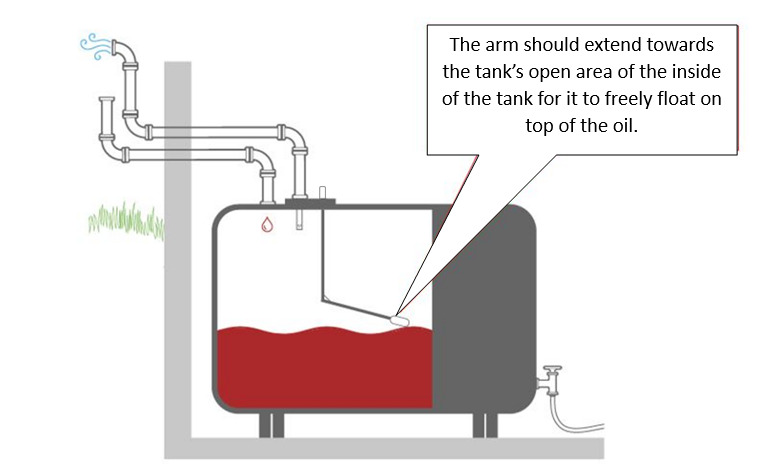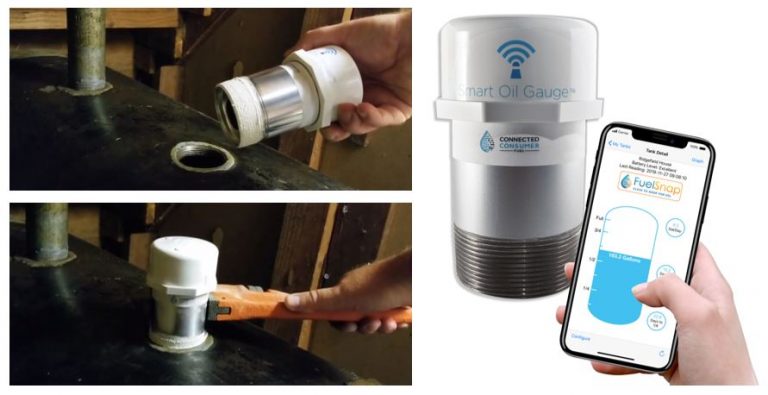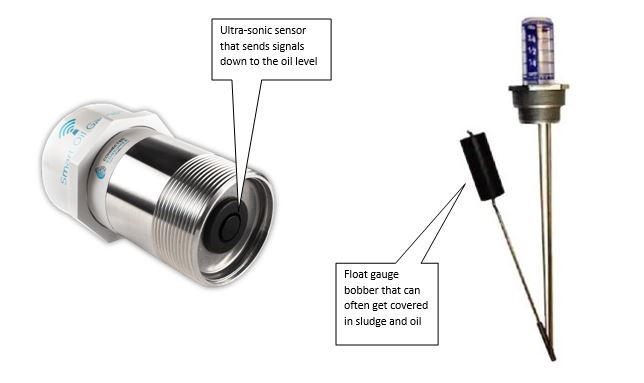Heating Oil Gauges have improved vastly over the past few years. With the inclusion of the Smart Oil Gauge, getting an accurate reading is easier than ever! Your heating oil tank is now at the tip of your finger! However, that begs the question. What about your float gauge? While the float gauge will still see a lot of use today, can it contend with the accuracy of the Smart Oil Gauge? I’ll be covering that in this article!
The Float Gauge
The Float Gauge is easily one of the most popular ways to keep track of your tank’s oil level. It operates off of a metal arm with a cork bobber at the end of it. The bobber on the arm connects to a plastic cylinder with a little plastic disk. The plastic cylinder and the interior disk work in conjunction with each other. The plastic cylinder is marked to determine what the oil level is with the help of the bobber. Depending on what your oil level will affect what the gauge will be reading and where the bobber will be.

One important thing for using a float gauge is to know your tank size. That will help understand roughly how many gallons you have in your oil tank. Considering most tanks are either 275-gallon or 330-gallon tanks, you’ll likely have to work with one of those. But on the off chance that you don’t have a tank of that size be sure that you know what size tank you have so that you can understand your reading accordingly.
The Smart Oil Gauge
The Smart Oil Gauge is a wireless tank sensor that connects to your WIFI to be able to transmit data to our servers. Once you successfully set up the gauge, simply plug in your tank information and install it onto the tank! The gauge will be able to read for your tank size in particular. If you don’t see your tank listed in the available tank sizes, feel free to reach out to us and we’ll provide you with a custom tank size!
It’s important that with the Smart Oil Gauge, you have it connected to a stable internet connection. If the gauge has a strong signal that it can continue to connect to, then the Smart Oil Gauge will be able to upload to our servers regularly without issues.

The Smart Oil Gauge comes in several different models. The two most prevalent models are the standard Smart Oil Gauge and the Smart Oil Gauge Duo. The standard gauge has an operating distance of 8″-72″ because of the 8″ blind spot. But the Duo doesn’t have that 8″ blind spot because of its dual-sensor functionality. Due to that, the Duo has an operating range of 0″-72″. We discuss the differences between the Duo and Standard gauges in-depth in this article here if you’d like to learn more!
Comparing the Two Gauges
When comparing the float gauge and the Smart Oil Gauge, it’s important to know what they can and cannot do. You can have both gauges installed onto the tank at the same time to get the best of both worlds. However, if you want to only use one of them, then it’s important to know their differences.
For using the Smart Oil Gauge, it’s important to know what size tank you have. This is because the gauge needs to know what tank size it’s reading for so that it can function correctly. If you have a 275-gallon horizontal tank, it’s important to configure the gauge for that tank size so it reads accurately. With the float gauge, however, it won’t be able to tell what tank it’s being installed to. So it’s up to you to figure out how many gallons of oil are in your tank based on what the float is reading. The float also cannot accommodate the curvature of a tank. Meaning that once you reach a certain point, the gauge might be reading less oil faster.
With the float gauge, as time goes on, oil and sludge will coat the bobber. This can cause the float gauge to become less accurate as time goes on. The bobber will then become bogged down with the oil and sludge causing the gauge itself to read less oil, or even be stuck on the bottom of the tank. The bobbers are sometimes hard to clean, but you can always replace them. However with the Smart Oil Gauge, because it has no arm and bobber, the gauge will very rarely have oil on the sensor.

Sometimes when you receive a delivery of oil, it can splash up around the sensor. Although that is rare, you can clean it off easily. Instead, the gauge uses an ultrasonic sensor that doesn’t require it to have a float gauge-style arm. The gauge will simply send a signal down to the oil level, that will then bounce back up to the sensor.
Finally, the Smart Oil Gauge is something that you can access anywhere from your phone. As long as the gauge has a stable WIFI connection, it can connect and upload to our servers. You’ll then be able to check your phone to get your tank’s reading from anywhere! However, with the float gauge, you’ll need to go down to the tank location to view the oil level in the tank.
Which Gauge Should You Use?
Whichever gauge you decide to use is completely up to you. You are more than welcome to use both! Most of our clients use both the Smart Oil Gauge alongside their float gauge! This gives them the best of both worlds!
But, in terms of accuracy, the Smart Oil Gauge is the more accurate gauge. It accounts for your tank’s curvature and uses an ultrasonic sensor to send a signal down to the oil level where it’s able to give you a more accurate reading based on your tank size!
Over time, the Smart Oil Gauge will even be able to maintain its accuracy! It won’t get bogged down and covered in sludge and oil, and will continue to read accurately due to no additional parts that go into the tank!
Happy Heating,
Hunter



